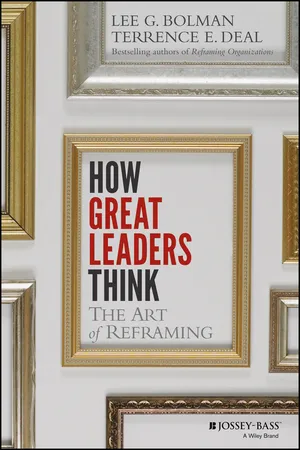
- English
- ePUB (mobile friendly)
- Available on iOS & Android
About this book
The proven model that offers powerful and elegant strategies for leaders
How Great Leaders Think: the Art of Reframing uses compelling, contemporary examples to show how more complex thinking is the key to better leadership. Leaders who understand what's going on around them see what they need to do to achieve the results they want. Bolman and Deal's influential four-frame model of leadership and organizations—developed in their bestselling book, Reframing Organizations: Artistry Choice and Leadership— offers leaders an accessible guide for understanding four major aspects of organizational life: structure, people, politics, and culture. Tapping into the complexity enables leaders to decode the messy world in which they live, see more options, tell better stories, and find strategies that are more effective. Case examples of leaders like Jeff Bezos at Amazon, Howard Schultz at Starbucks, Tony Hsieh at Zappos, Ursula Burns at Xerox, and the late Steve Jobs at Apple provide concrete lessons that readers can put to use in their own leadership. The book's lessons include:
- How to use structural tools to organize teams and organizations for better results
- How to build motivation and morale by aligning organizations and people
- How to map the terrain and build a power base to navigate the political dynamics in organizations
- How to develop a leadership story that shapes culture, provides direction, and inspires commitment to excellence
Frequently asked questions
- Essential is ideal for learners and professionals who enjoy exploring a wide range of subjects. Access the Essential Library with 800,000+ trusted titles and best-sellers across business, personal growth, and the humanities. Includes unlimited reading time and Standard Read Aloud voice.
- Complete: Perfect for advanced learners and researchers needing full, unrestricted access. Unlock 1.4M+ books across hundreds of subjects, including academic and specialized titles. The Complete Plan also includes advanced features like Premium Read Aloud and Research Assistant.
Please note we cannot support devices running on iOS 13 and Android 7 or earlier. Learn more about using the app.
Information
Part 1
Leadership in Four Dimensions
Before we change the world, we need to change the way we think.—Russell Brand1A man cannot expect to progress without thinking.—Henry Ford2
NOTES
Chapter 1
Introduction
The Power of Reframing
JCP’s Ron Johnson was . . . clueless about what makes shopping fun for women. It’s the thrill of the hunt, not the buying . . . Women love to shop and deals are what make the game worth playing . . . Bargain hunting is now like playing a game—and finding deeply discounted goods on sale is part of the game.4
Table of contents
- Cover
- Contents
- Title
- Copyright
- Preface
- Acknowledgments
- Part 1: Leadership in Four Dimensions
- Part 2: Structural Leadership
- Part 3: Human Resource Leadership
- Part 4: Political Leadership
- Part 5: Symbolic Leadership
- Part 6: Improving Leadership Practice
- Appendix: Leadership Orientations
- The Authors
- Index
- End User License Agreement